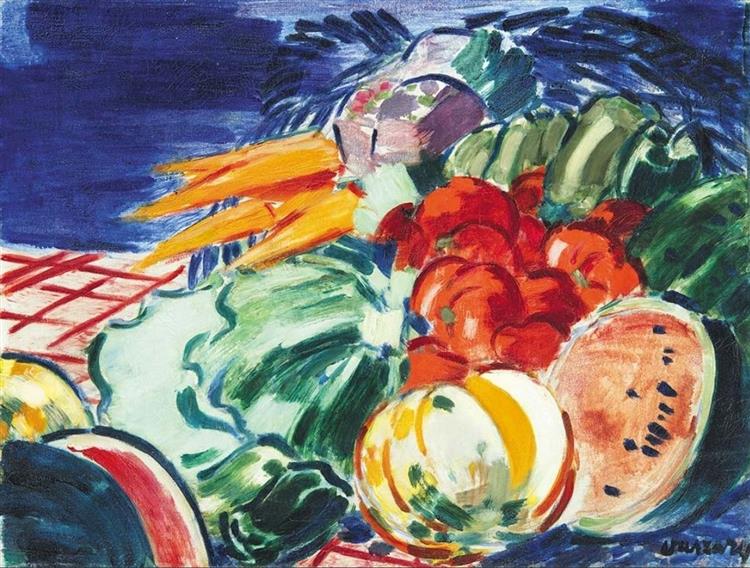Description
The painting "Dinnyés Csendélet" of 1938, created by the prolific Hungarian artist János Vasaryry, is a work that exquisitely captures the essence of the still life, A genre that has been explored and reimagined by numerous painters throughout art history. This work, in particular, is a testimony of the technical domain of Vasaryry and its ability to infuse life and vibration in a seemingly mundane subject.
At first glance, "Dinnyés Csendélet" attracts the viewer with the freshness and vigor of its composition. The work presents an arrangement of half -cut watermelons and whole, which are deployed at a table apparently casual but carefully organized. The watermelons, with their green shells and their juicy red pulp, constitute the focal point of the work. Vasaryy uses an impressive color management and texture to highlight the succulence of the fruit, creating a vibrant contrast between the green of the peel and the intense red of the interior, accentuated by the black seeds that score the meat of the fruit.
The background of the painting contributes to the visual wealth of the work. With a treatment that suggests a domestic environment but does not define it completely, Vascary leaves space for the viewer's interpretation. This blurred fund, although simple, enhances the prominence of watermelons, allowing melons to stand out with even more intensity. It is evident that Vascary understands the importance of negative space as much as the positive, creating a duality that is as visually pleasant as intellectually stimulating.
In terms of composition, Vasozary demonstrates a deep knowledge of spatial distribution. The arrangement of watermelons, some cut in halves and others in rooms, adds dynamism and variety to the work. The play of lights and shadows, reflected so naturally on the surface of the fruit and the table, reveals a subtle understanding of lighting and its impact on the perception of volume and shape.
János Vasaryry, born in 1867, was a central figure in the Hungarian artistic scene of his time, known for his versatility and his ability to move between different styles and genres with impressive ease. Although he began his career influenced by impressionism and symbolism, throughout his life he also explored expressionism and other modern currents. This eclecticism is palpable in "Dinnyés Csendélet", where impressionist influences can be glimpsed in its color and light management, but also an almost academic compositional structure.
The year 1938, in which this painting was created, it was a period of great creativity for Vasaryry, who during these years continued to rehearse with different techniques and themes. However, his inclination towards still life In this period it could be interpreted as a desire to capture the calm and constancy of inanimate objects in the midst of a convulsive outside world that was inexorably directed towards World War II.
In summary, "Dinnyés Csendélet" is a work that, although simple in its subject, is loaded with a vibration and energy that only a master Like János Vascary could achieve. The combination of intense colors and a carefully planned composition produces a work that is, at the same time, a delight for the senses and a clear sample of the talent and the deep sensitivity of the Hungarian artist. This painting not only celebrates the intrinsic beauty of the still life, It also highlights Vascary's ability to transform everyday life into a fascinating artistic and visual reflection theme.
KUADROS ©, a famous paint on your wall.
Hand-made oil painting reproductions, with the quality of professional artists and the distinctive seal of KUADROS ©.
Art reproduction service with satisfaction guarantee. If you are not completely satisfied with the replica of your painting, we refund your money 100%.

